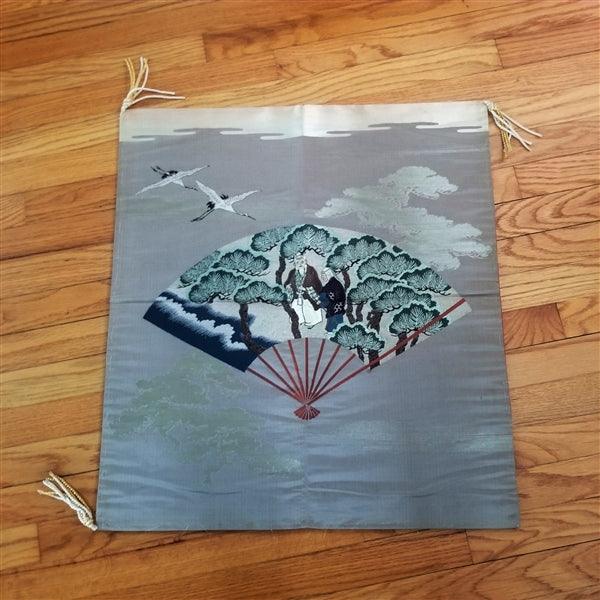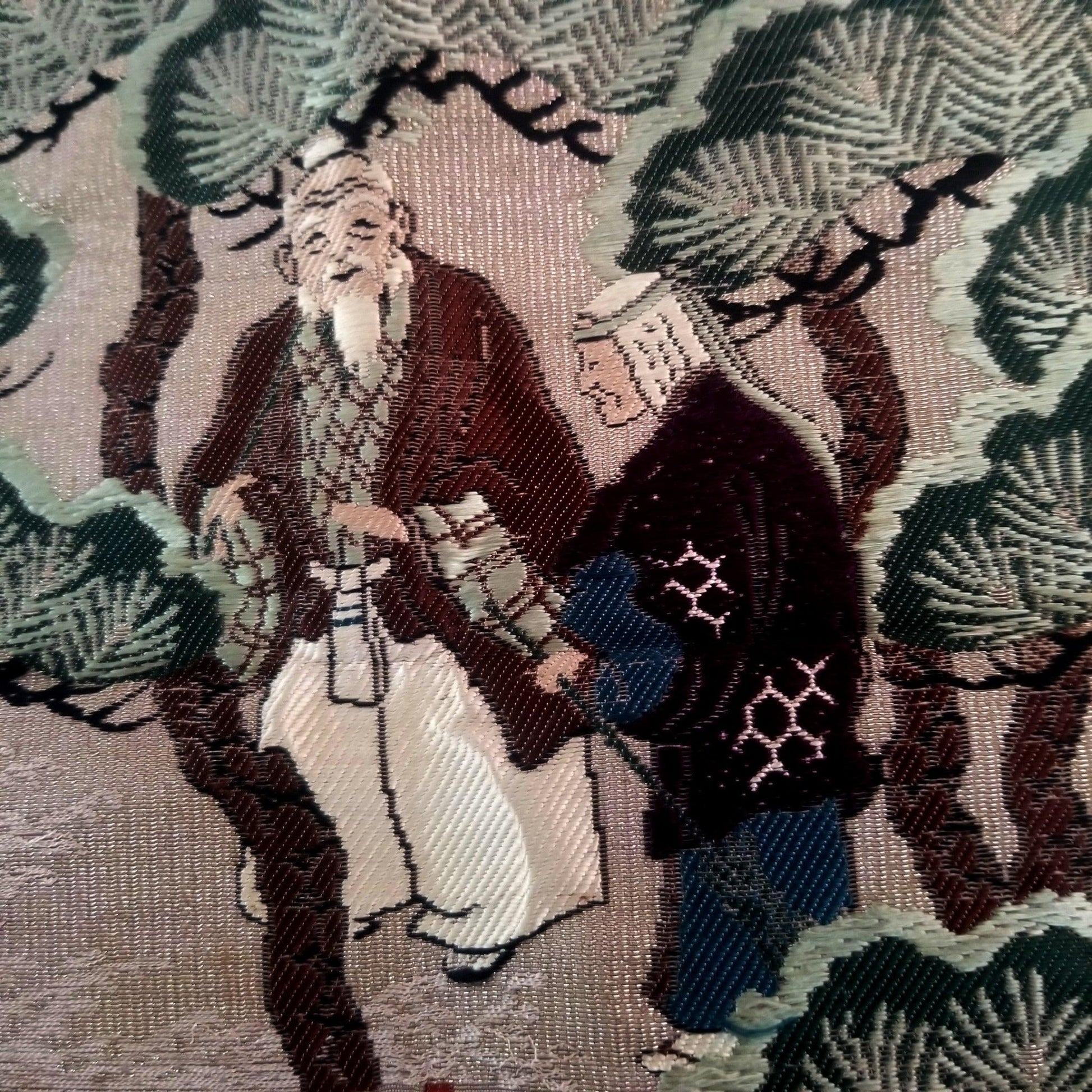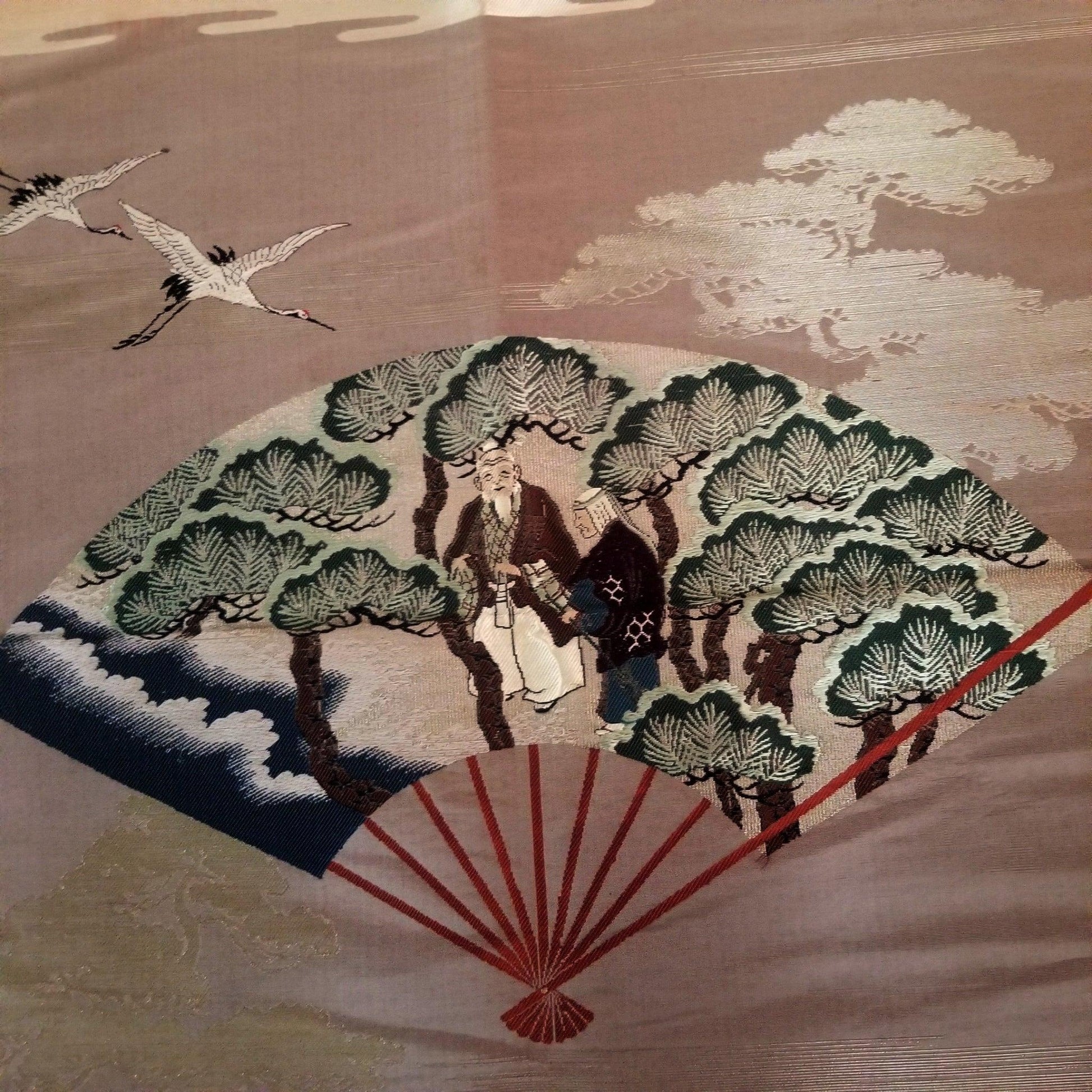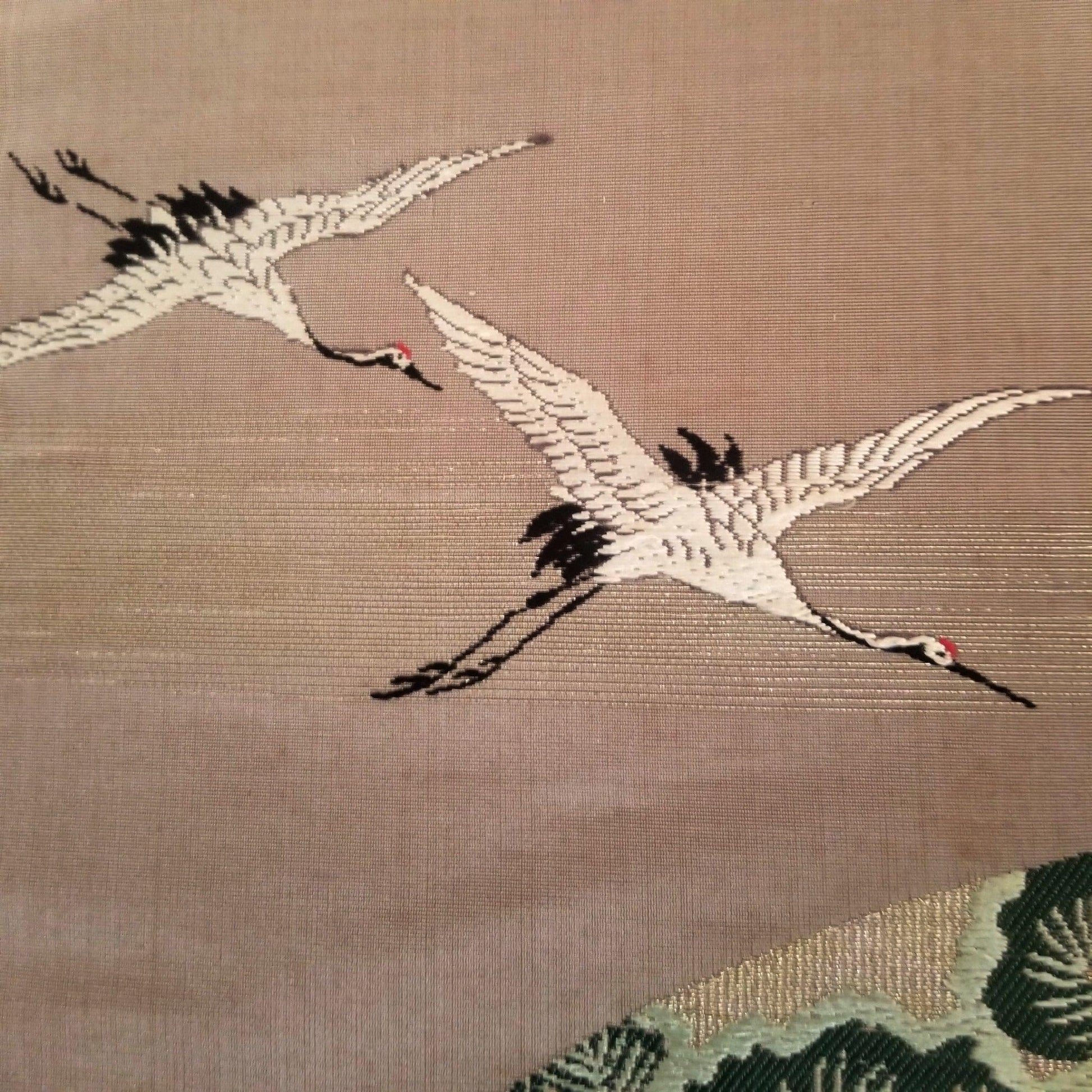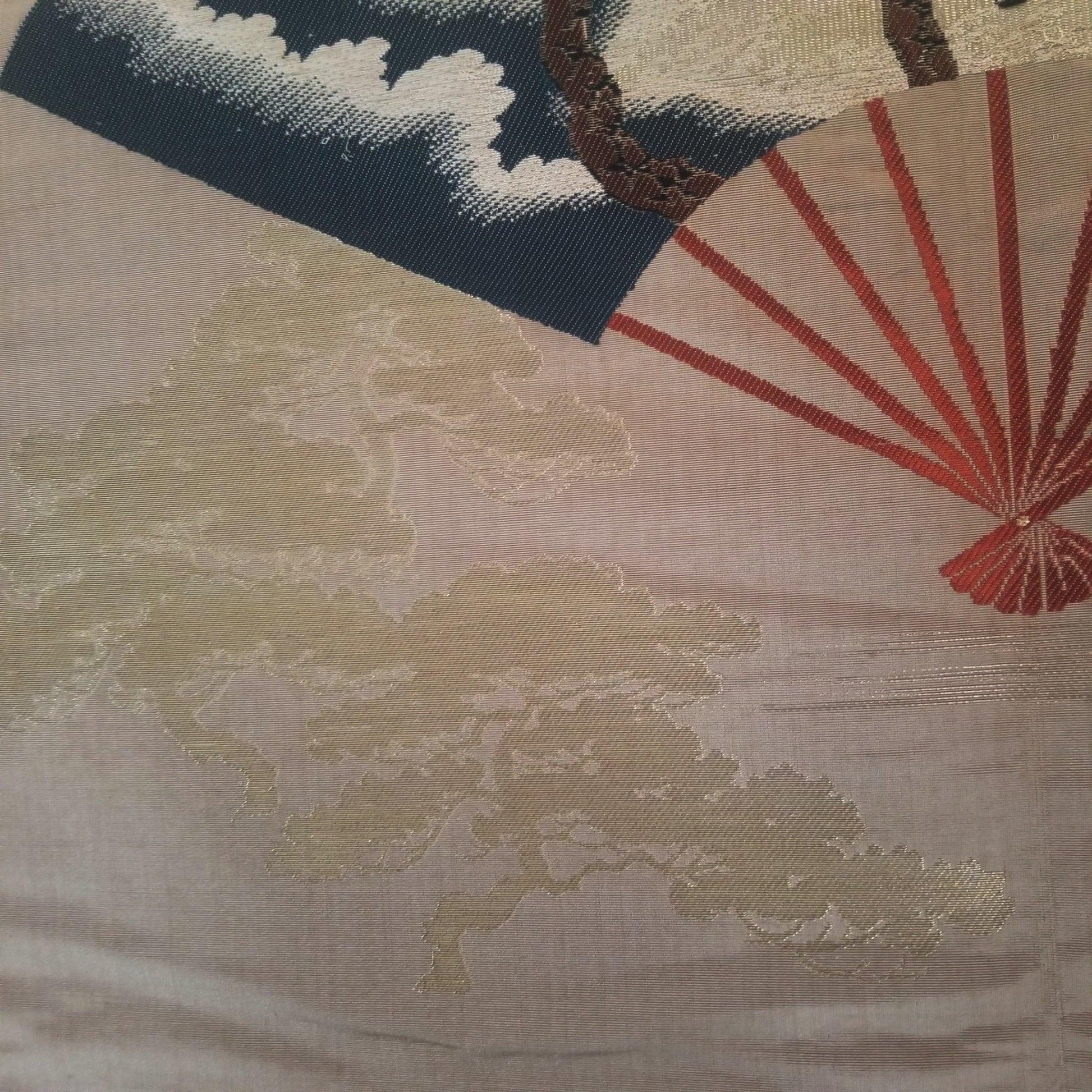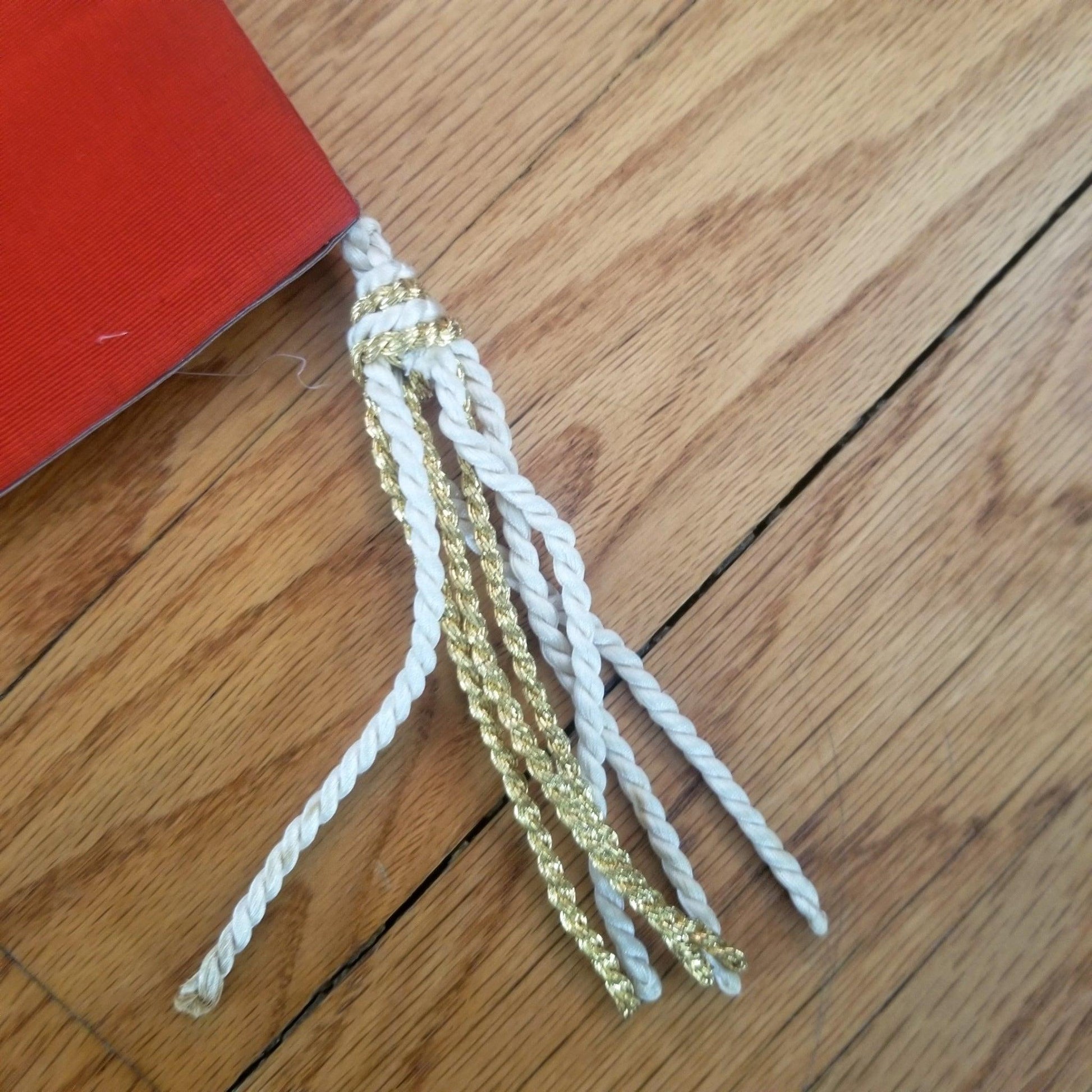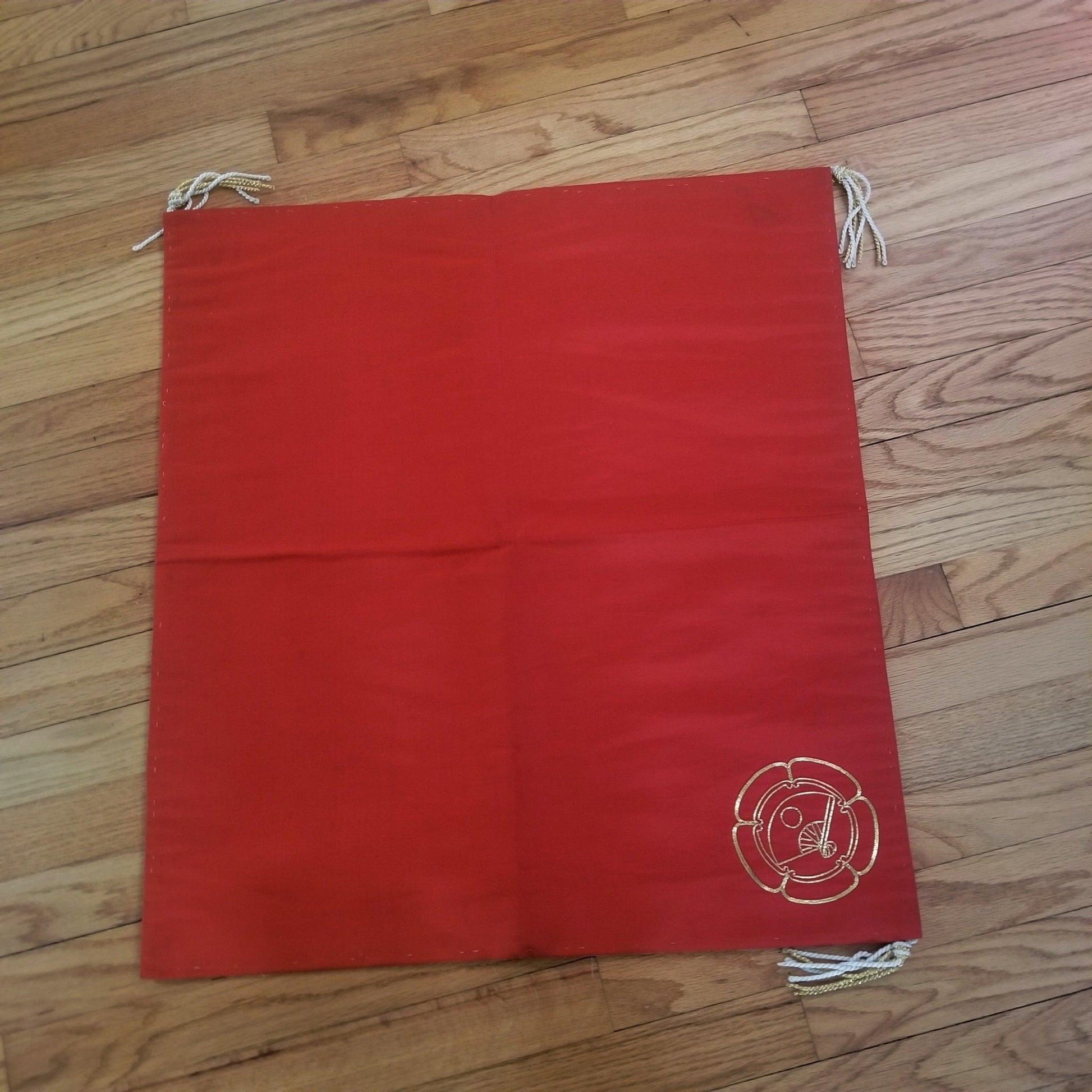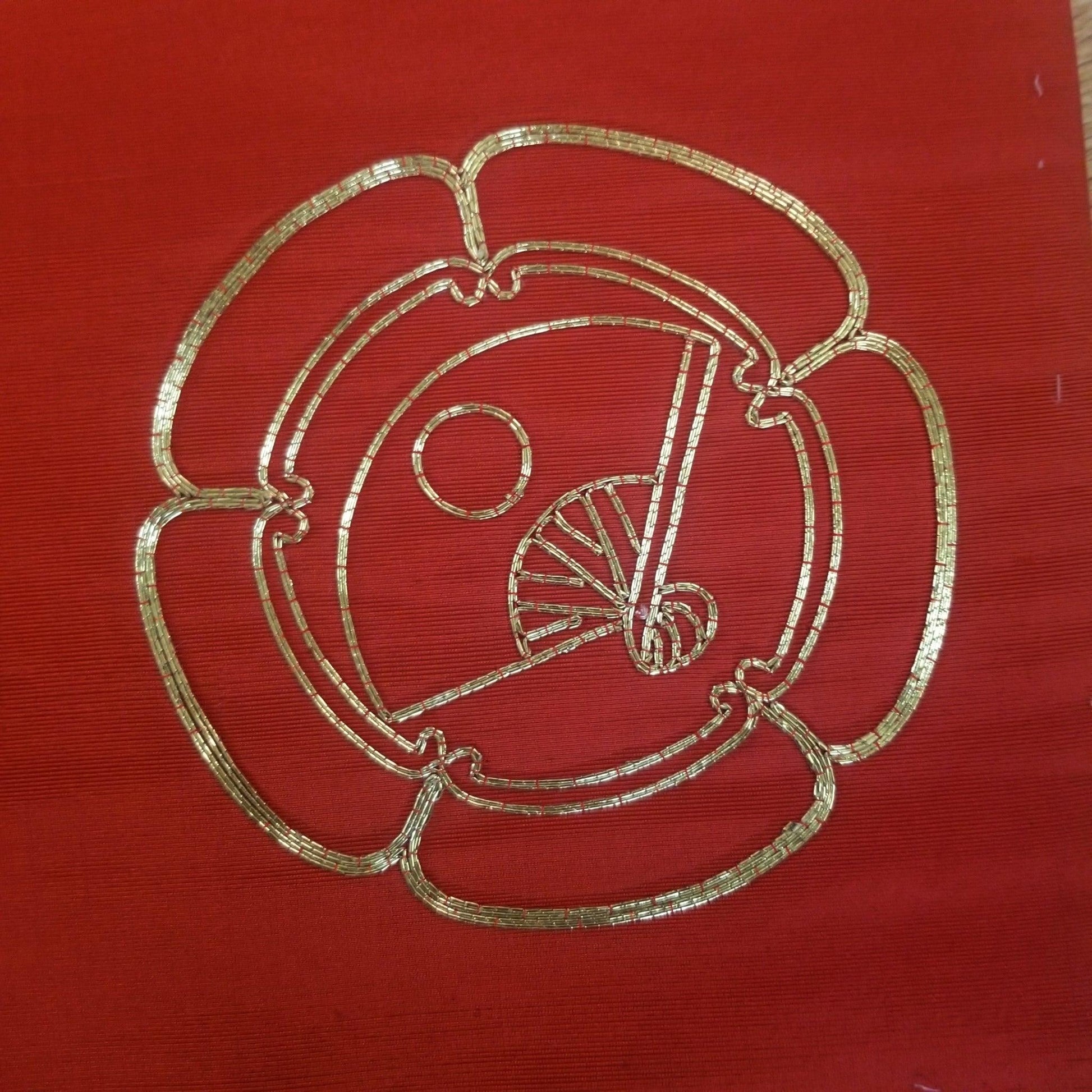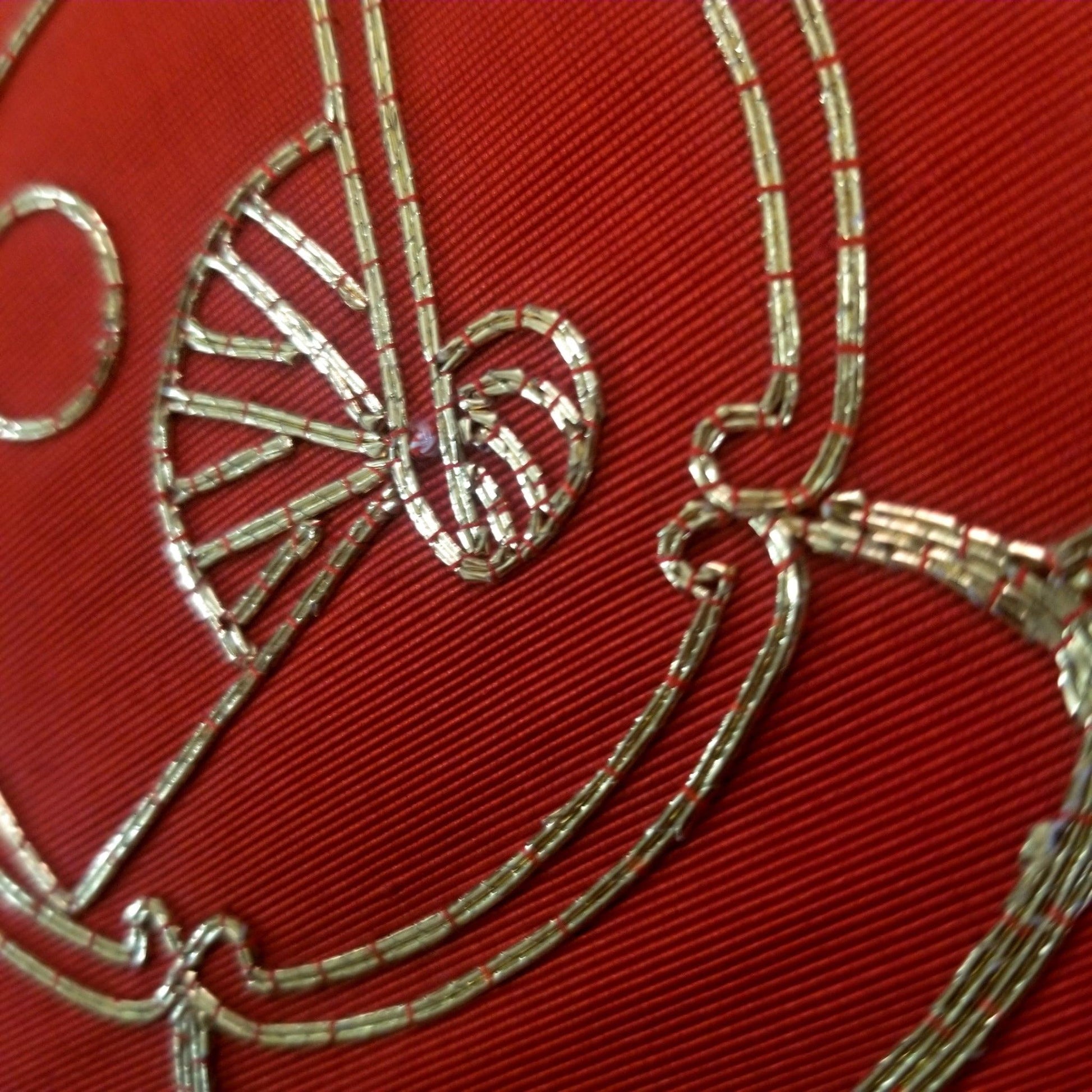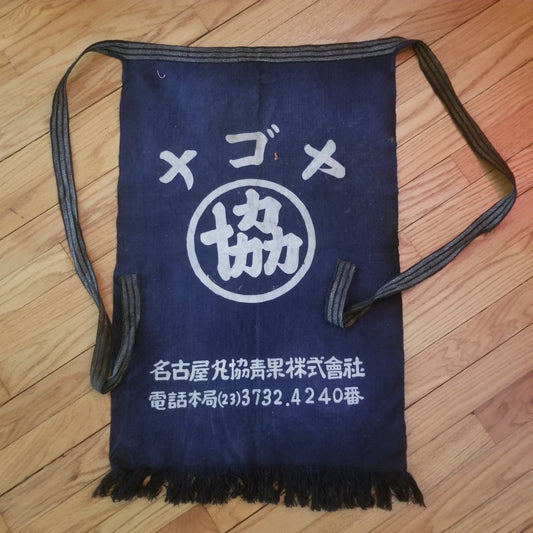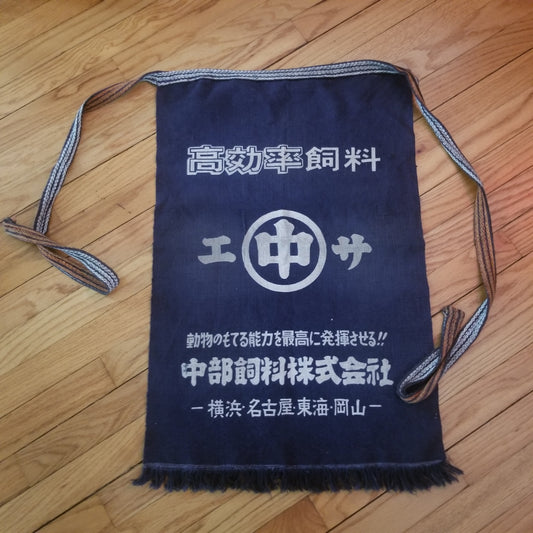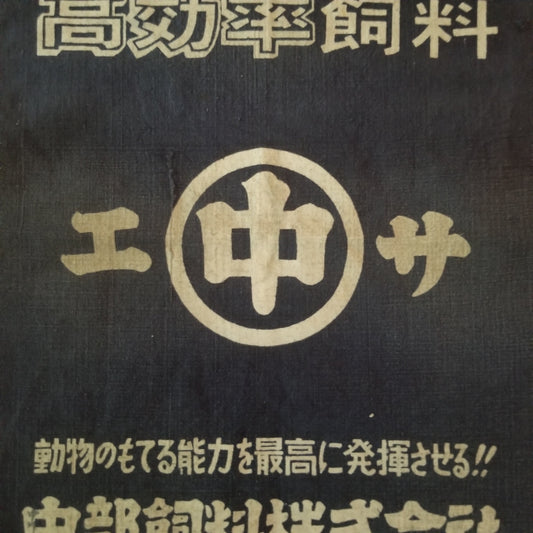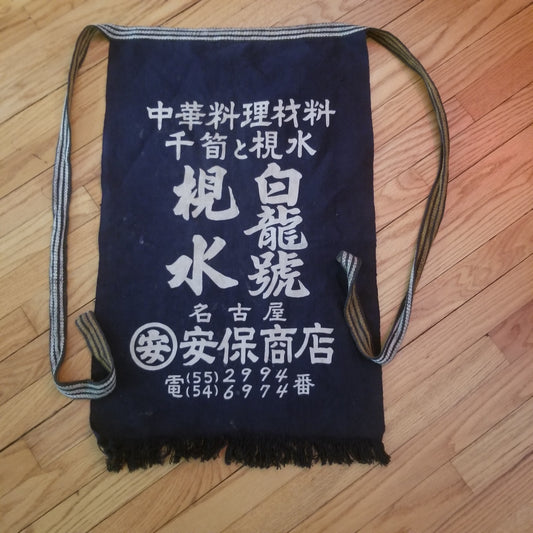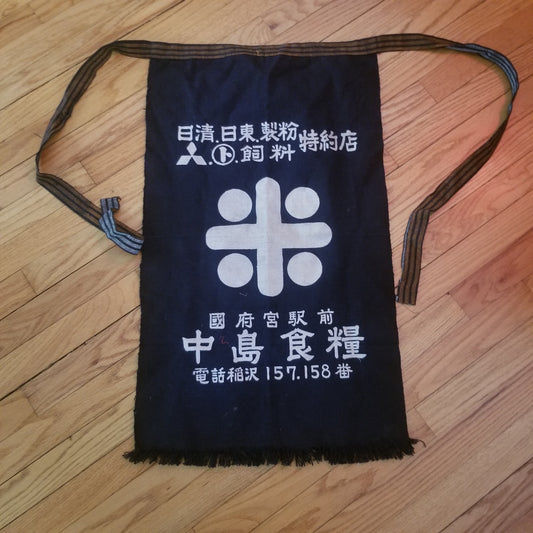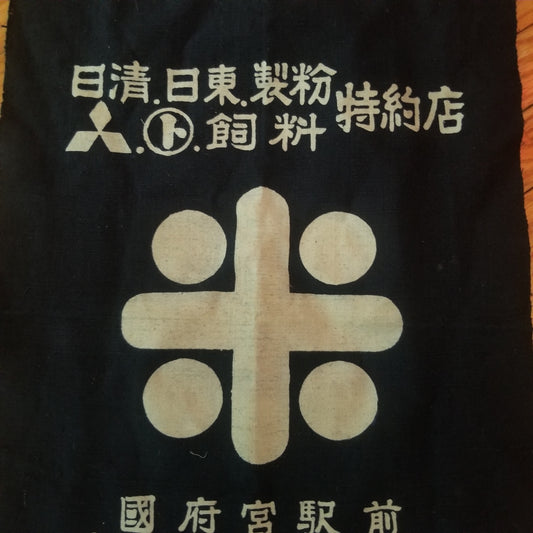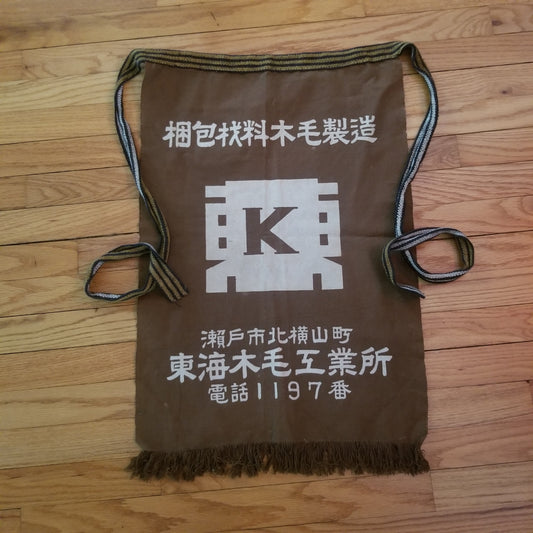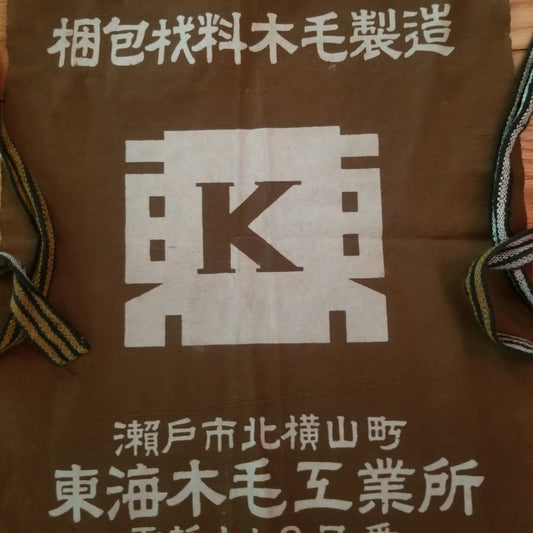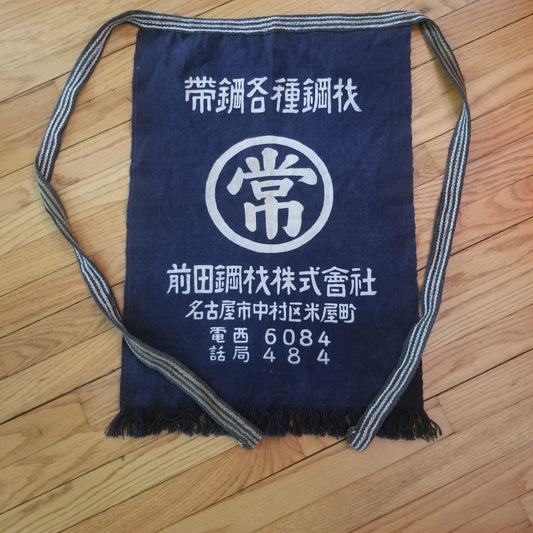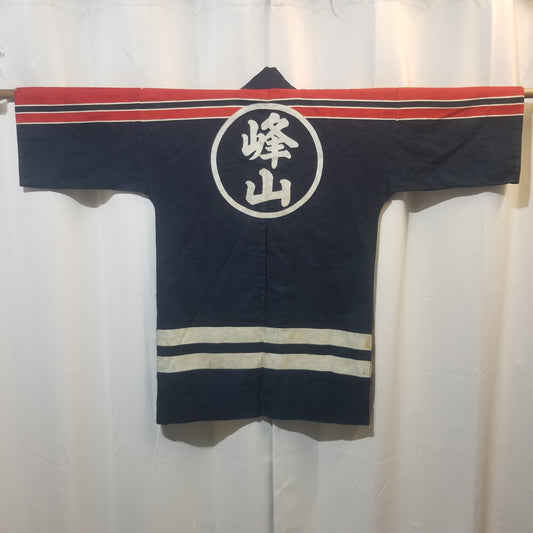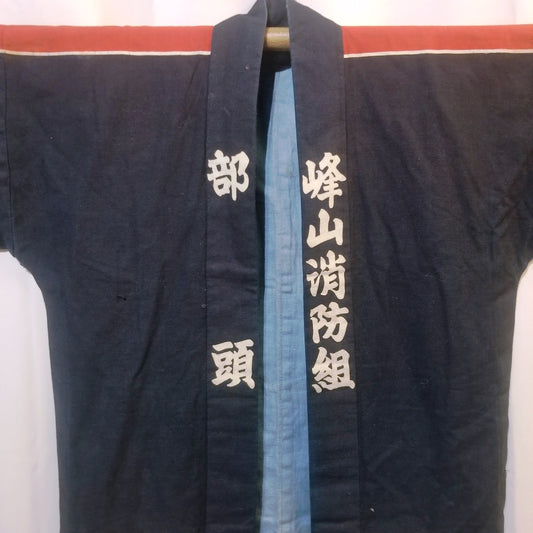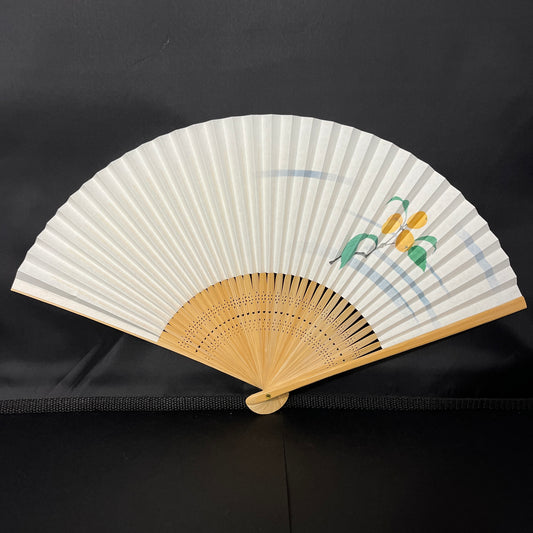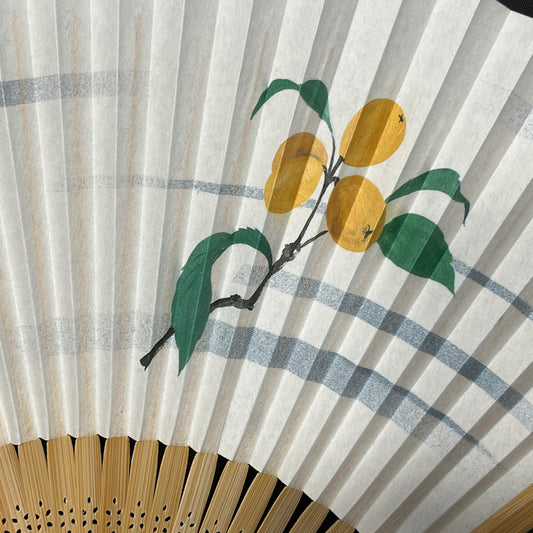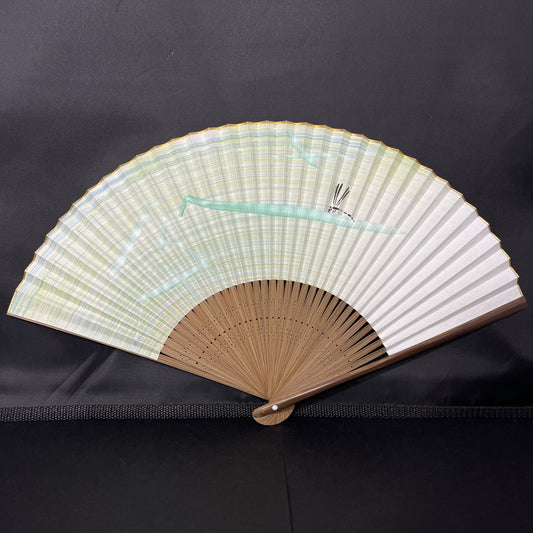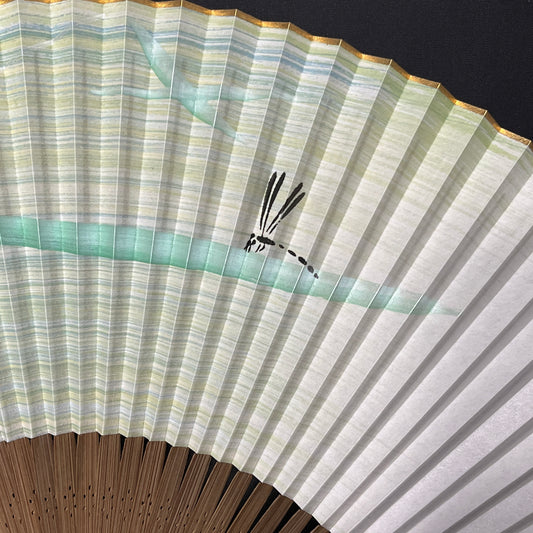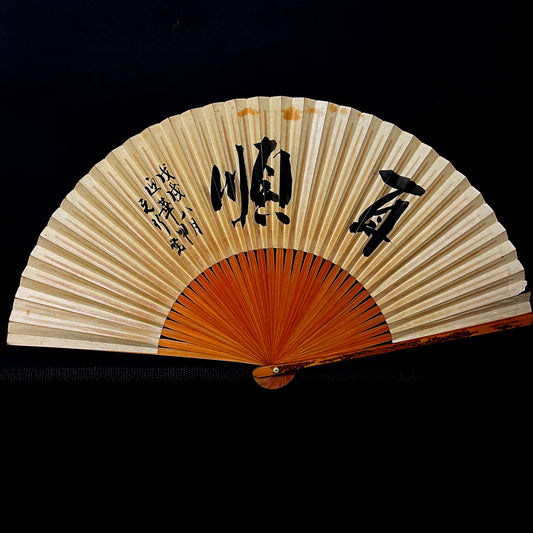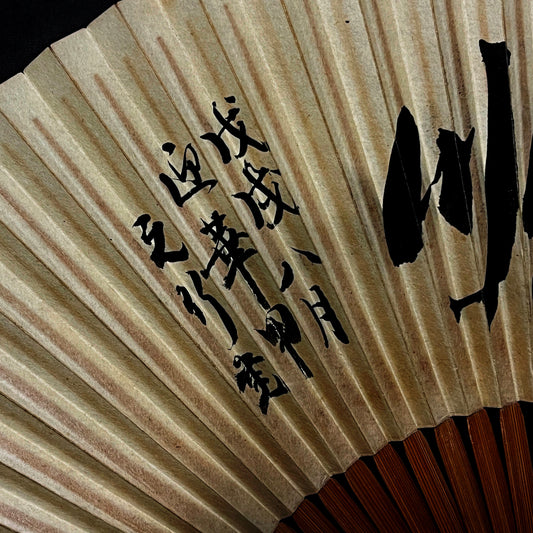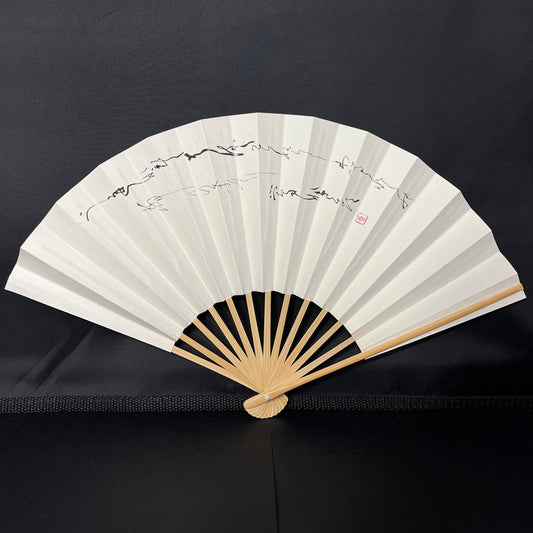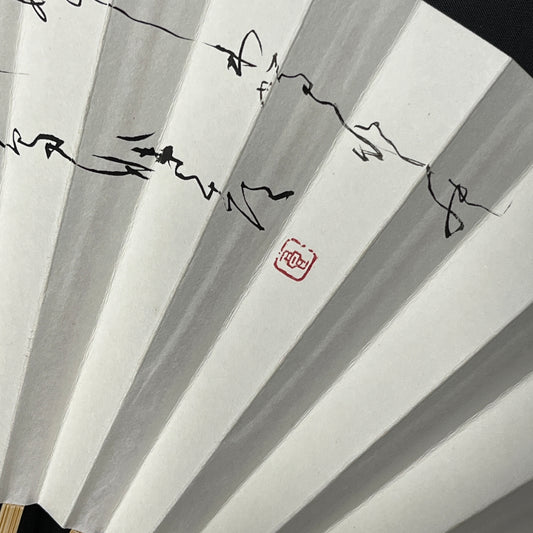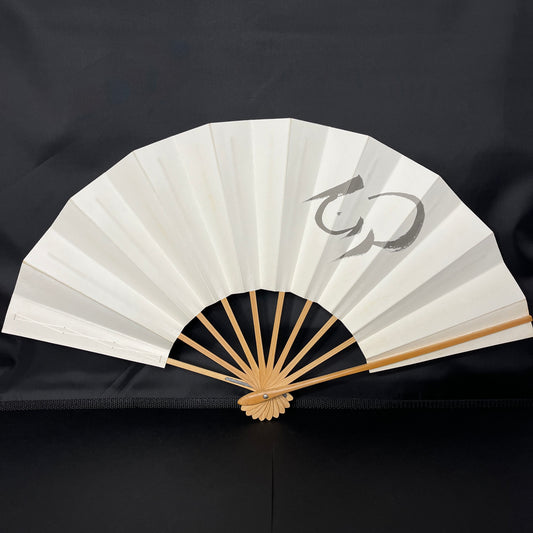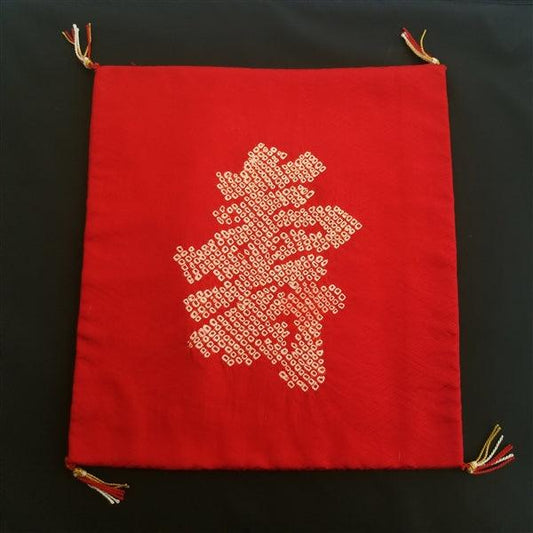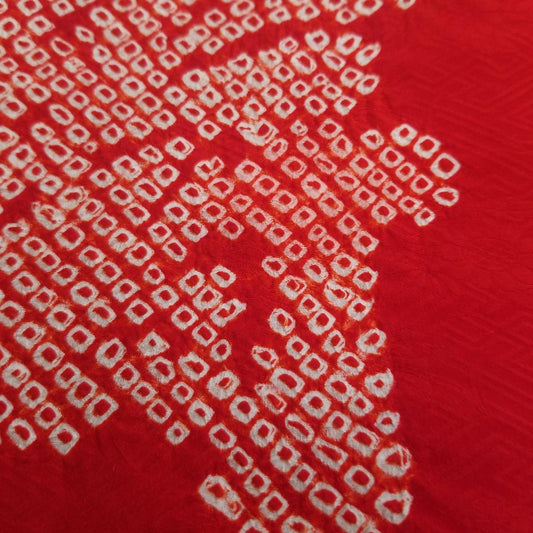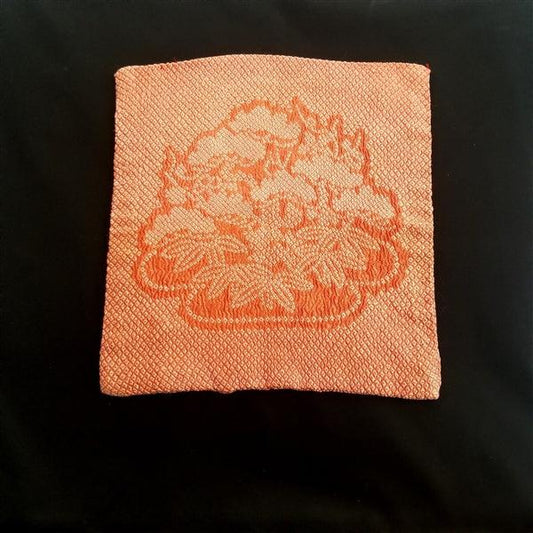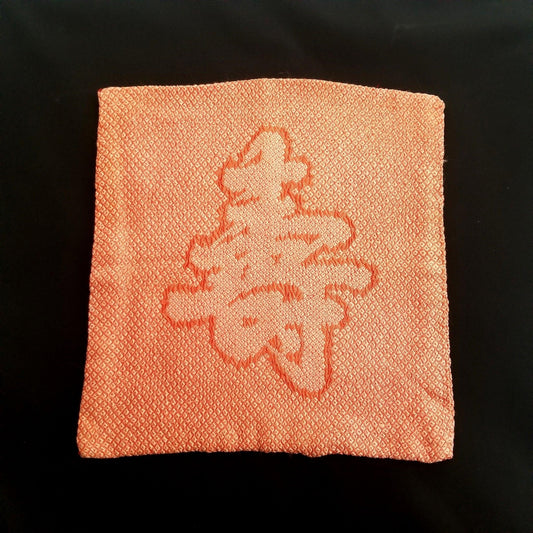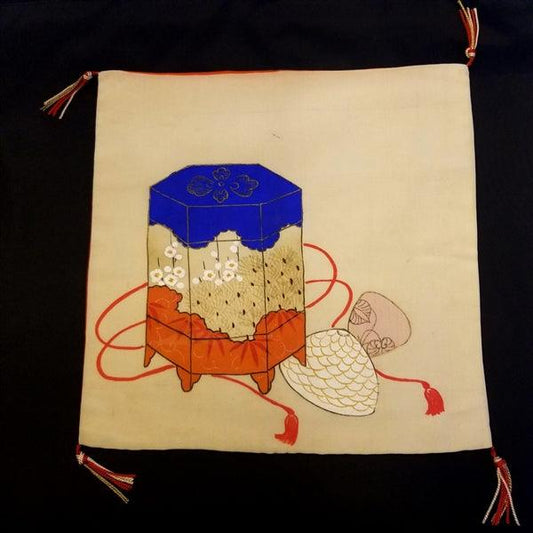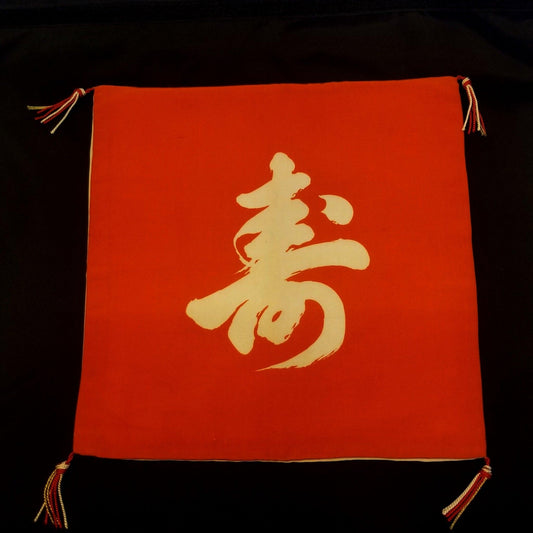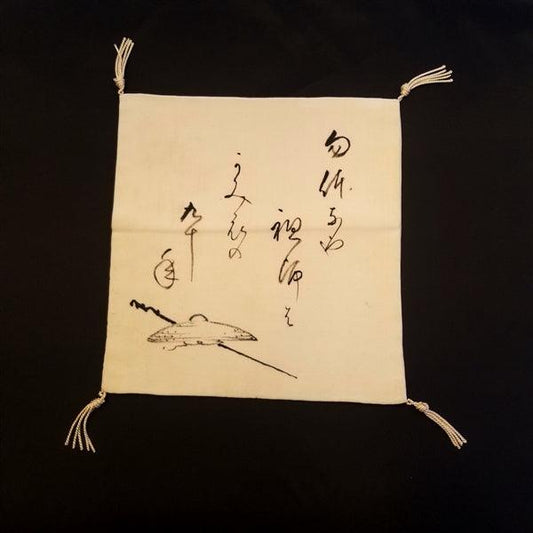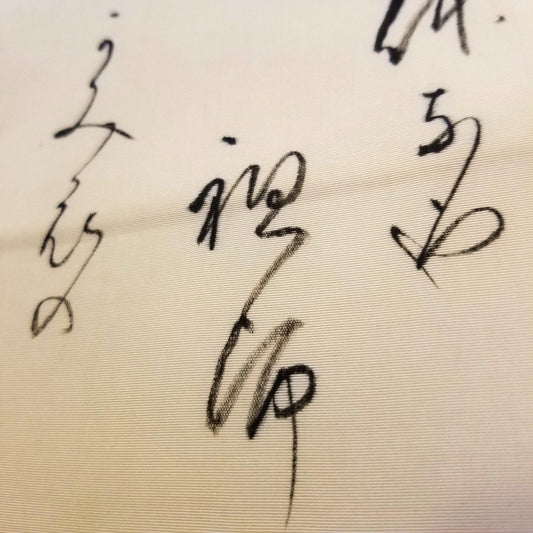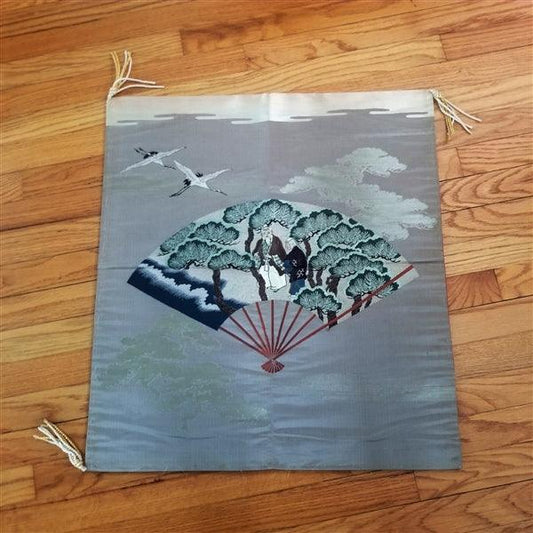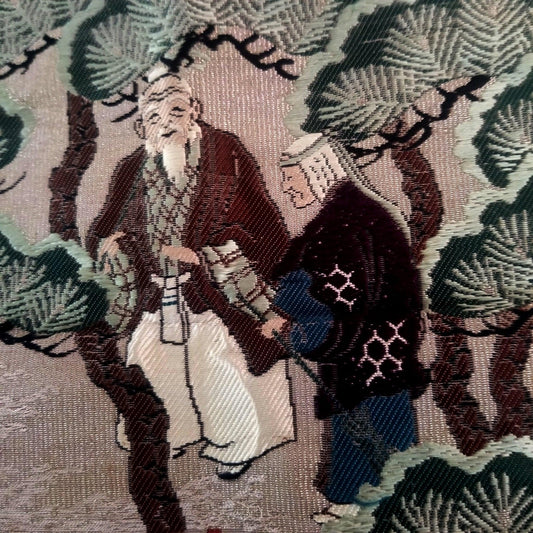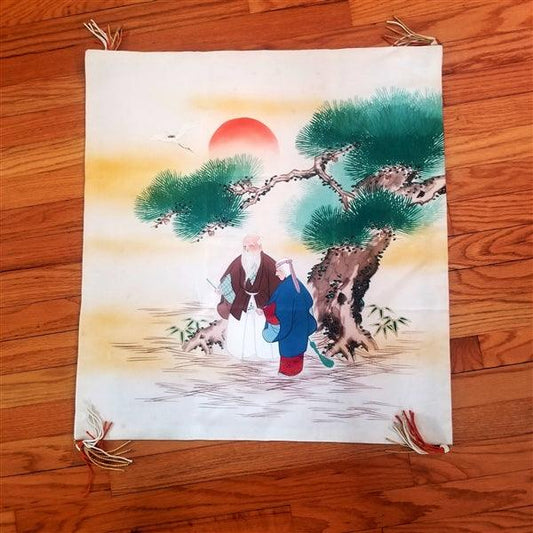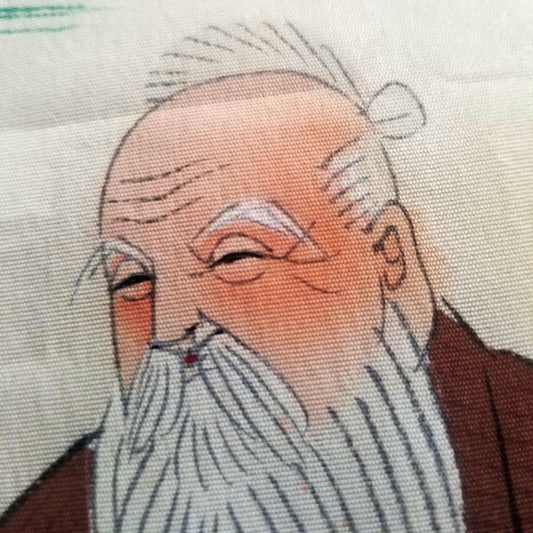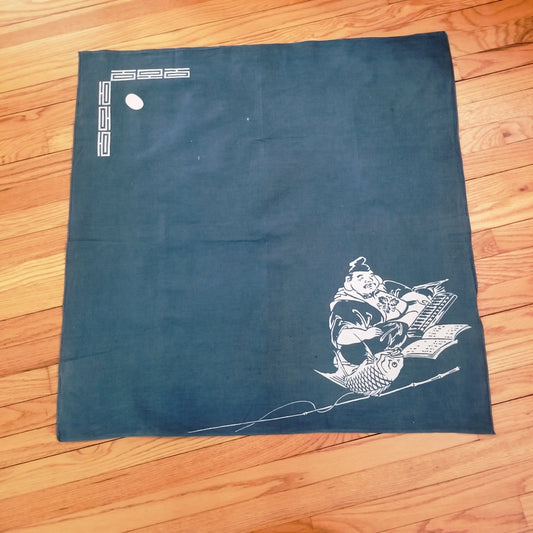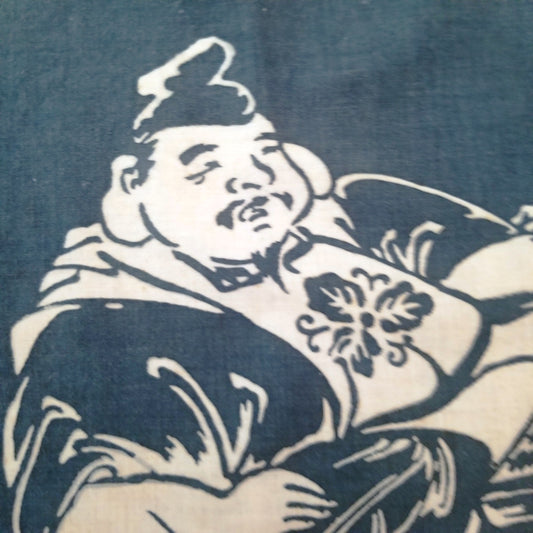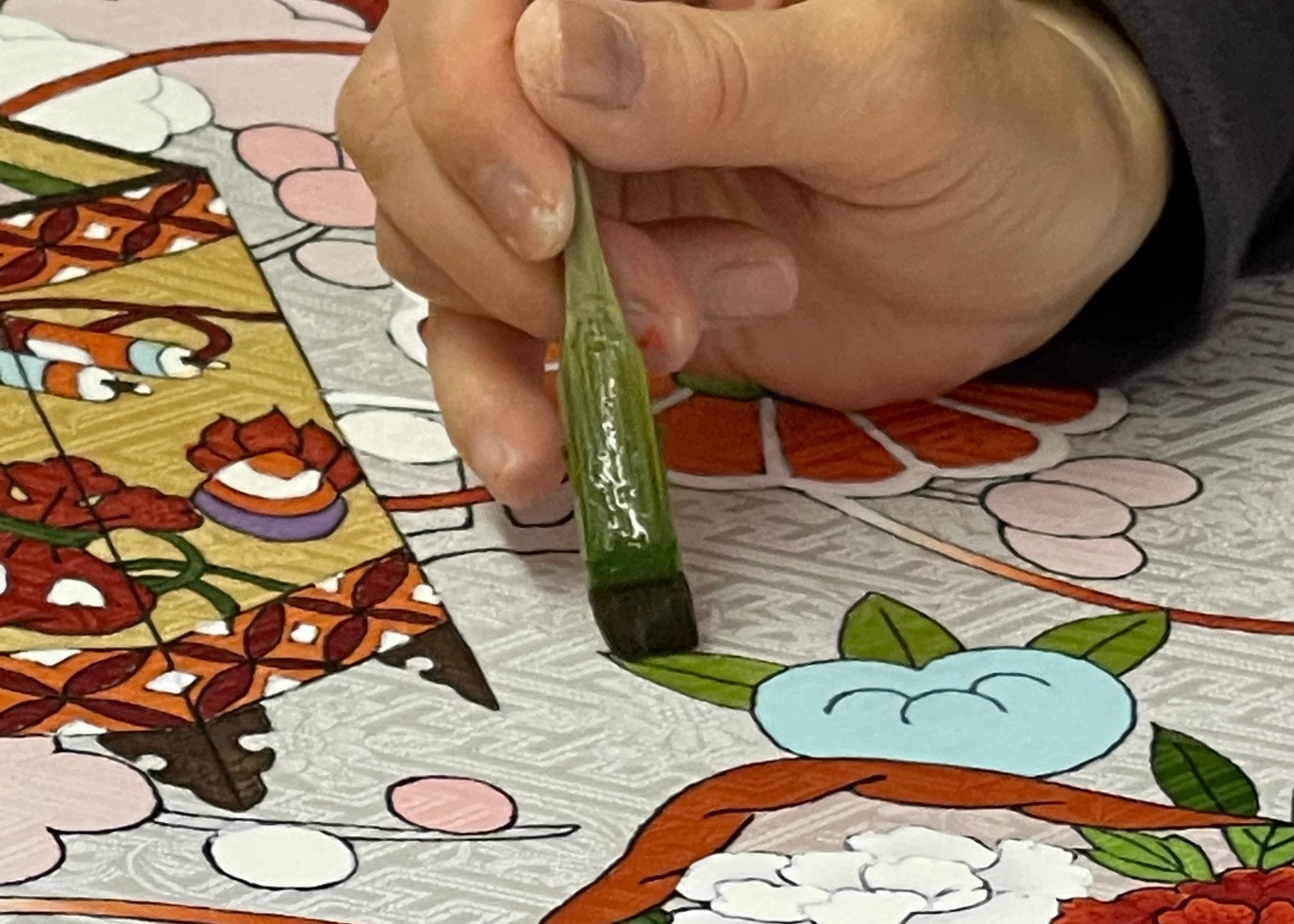"Jo and Uba Brocade" Antique Fukusa
"Jo and Uba Brocade" Antique Fukusa
Brocade Weave
Couldn't load pickup availability
- Ships from NY
- One-of-a-kind
- Sourced from Japan
This fukusa features characters from one of the most iconic Japanese myths associated with weddings and marriages. This elderly couple - Jo and Uba - represent a long and happy marriage. Uba carries a broom to sweep away troubles, and Jo carries a rake to rake in good fortune. Learn more about the myth and characters here. In this scene, the couple is part of the decoration on a large folding fan.
The fukusa is woven silk with a brocade density in the fan motif that allows it to pop a bit from the smooth silk background. It was likely woven with the fingernail weaving technique called tsuzure - see video below for how that is done.
Whtie and gold tassles hang from each corner. The backside is the traditional red silk crepe with a large gold family crest in one corner. The crest - a folding fan inside a scalloped border - was created with couched gold threads. So much fine hand work.
From Wikipedia:
Fukusa are a type of Japanese textile used for gift-wrapping....Fukusa are square or almost square pieces of lined fabric ranging in size from about 9–36 inches (230–910 mm) along one side. They are typically made of fine silk, and may be decorated with embroidery in auspicious designs.
The use of fukusa as a way of presenting gifts has mostly died out, lingering instead mainly in certain ritual exchanges of gifts during weddings in a few regions of Japan.
Traditionally in Japan, gifts were placed in boxes or on a wooden or lacquered tray, over which a fukusa would be draped. The choice of a fukusa appropriate to the occasion was considered an important part of the gift itself, and part of its formality. The practice of covering a gift became widespread during the Edo period (1603-1867).
The scene or motifs depicted on fukusa are chosen to indicate either the occasion for which the gift is being given, or because they are appropriate for one of the annual festivals when gifts are exchanged. The richness of the decoration of the fukusa attests to the giver's wealth and aesthetics.
Once a gift was exchanged, after being admired, the fukusa and box or tray presented with the gift are typically returned to the gift's original giver. However, before the Meiji Restoration, when gifts were presented to a high official, the fukusa was not always returned.
Width: 24"
Condition: Excellent
Fiber: Silk
Technique: Woven
Colors: Gray, Multi
Motifs: Mythology, People, Figures, Auspicious Elements
SKU:0923fukusaFC21
Share with a Friend.

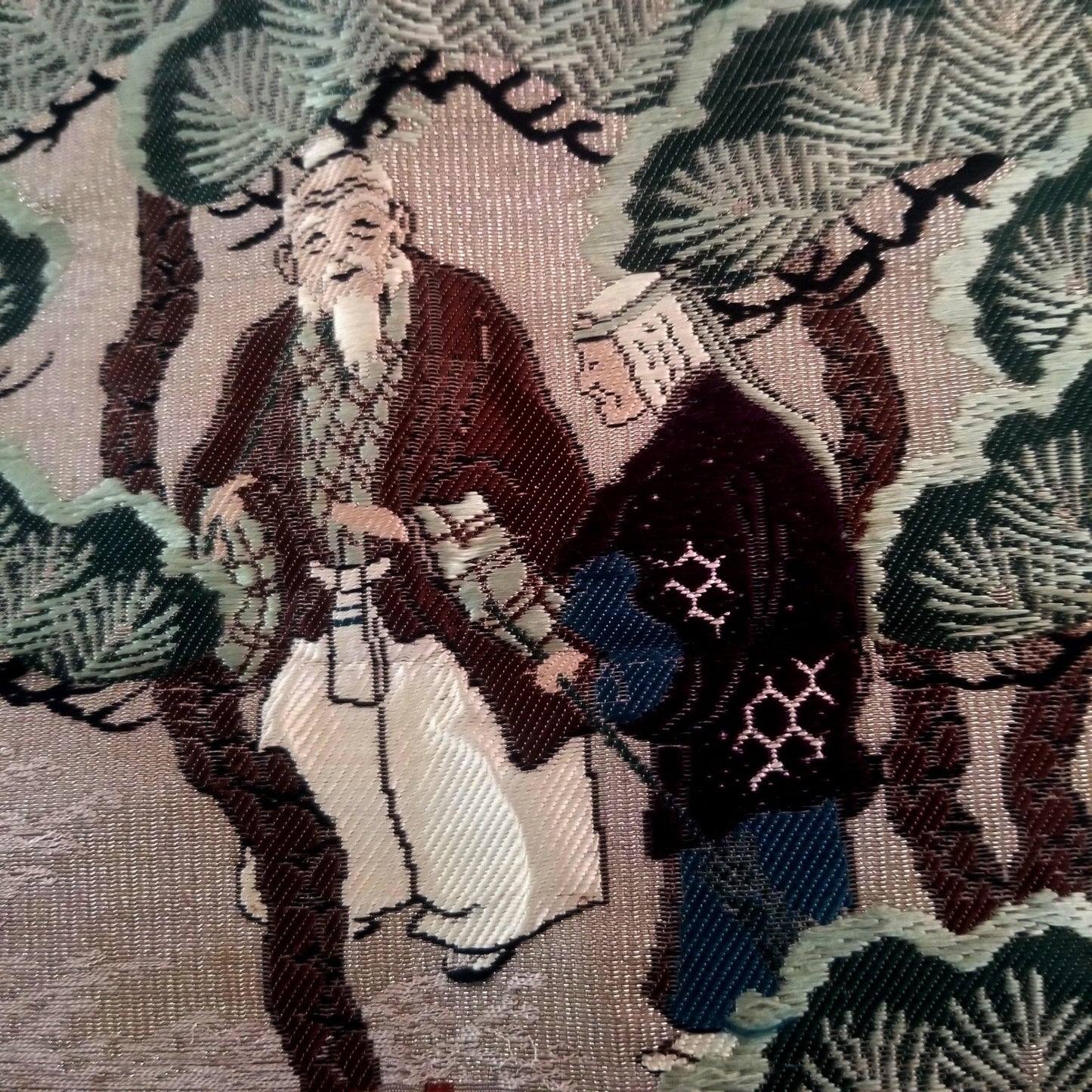

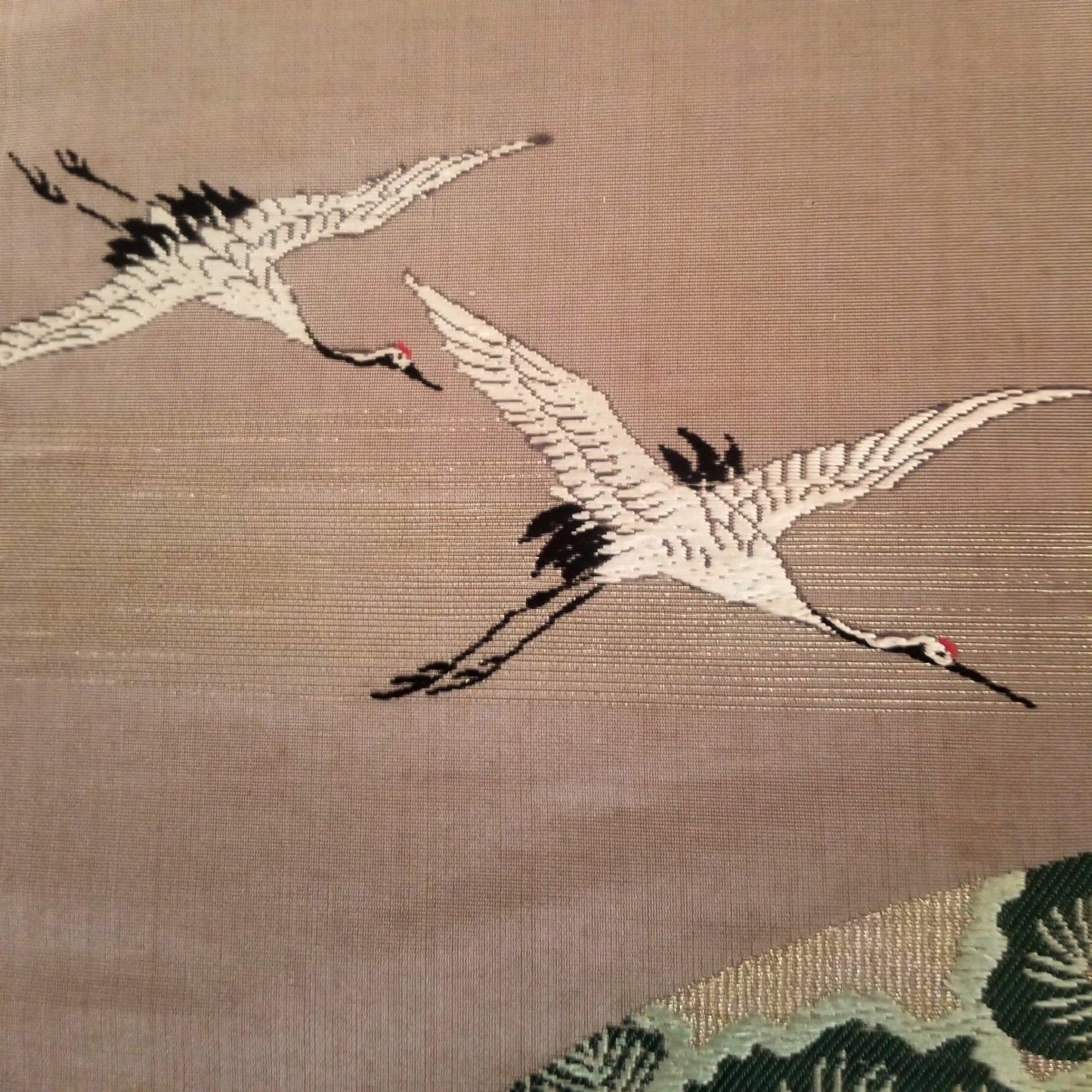
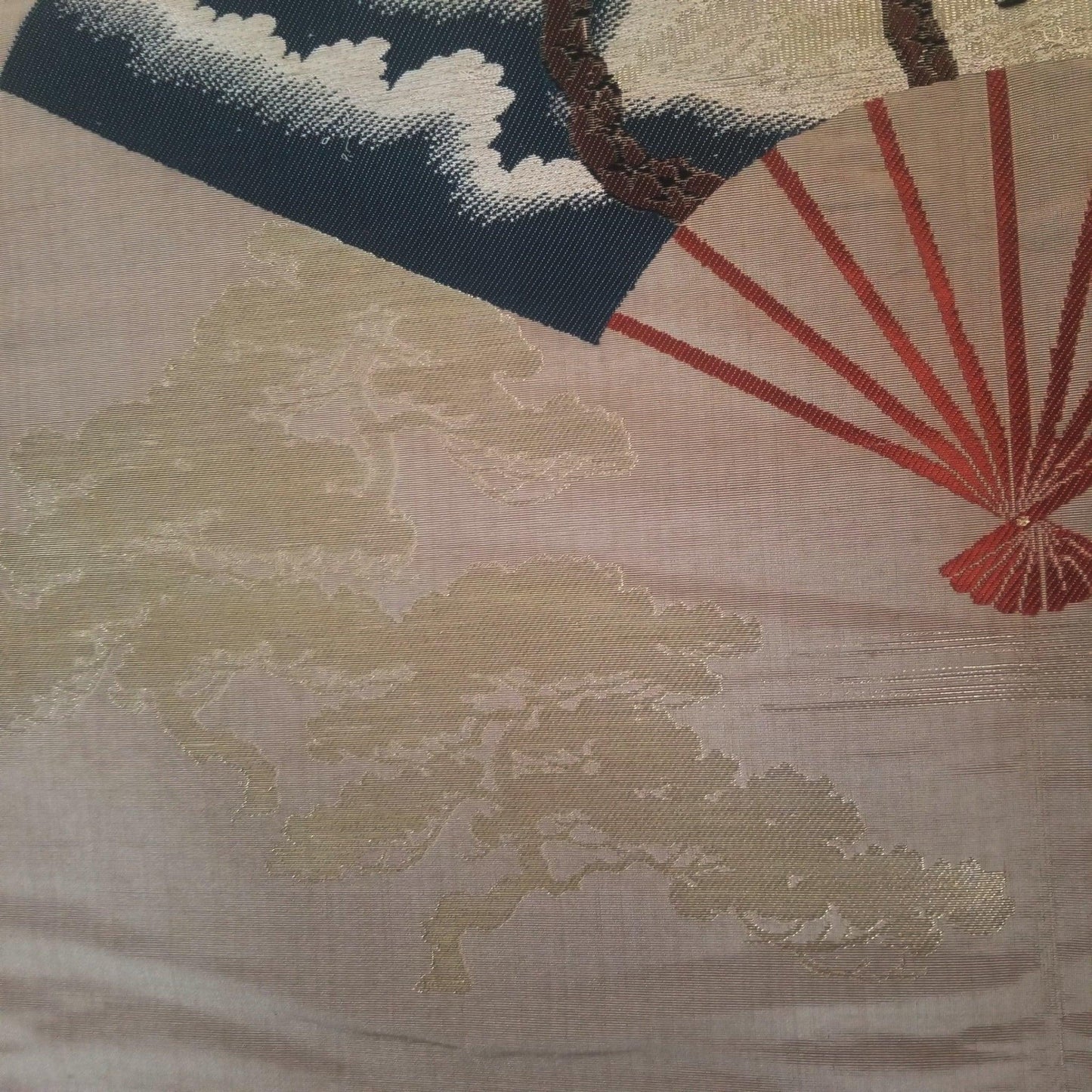

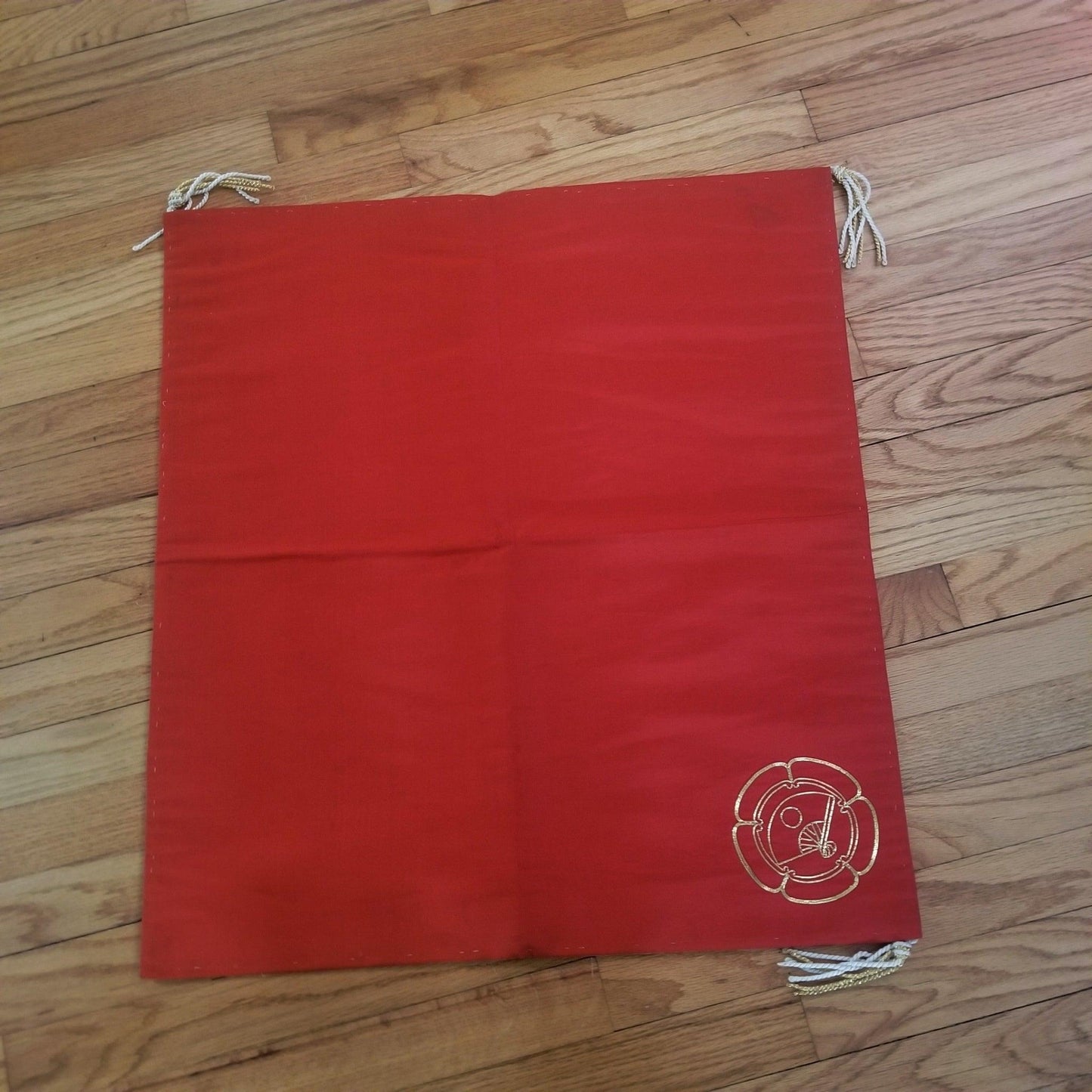
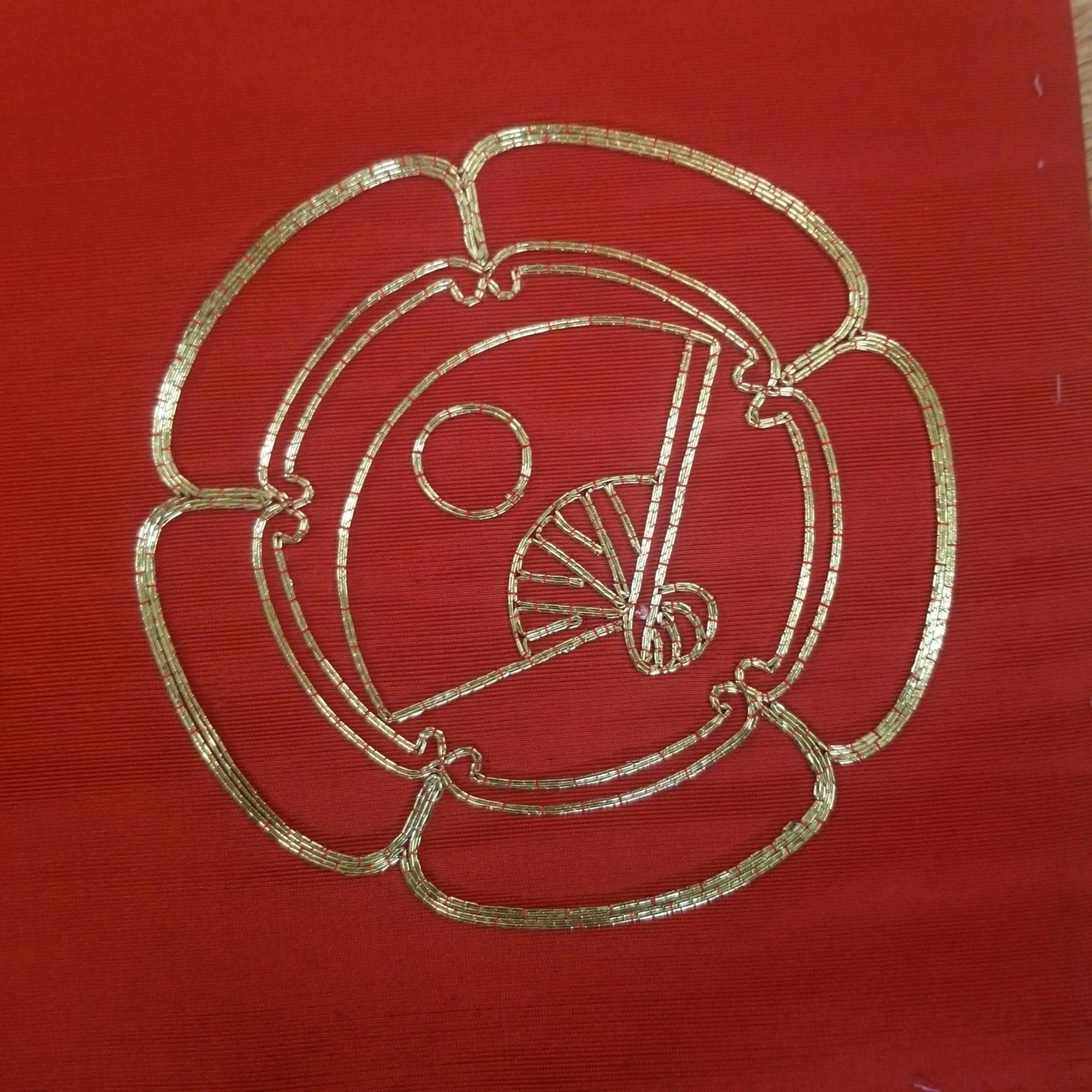
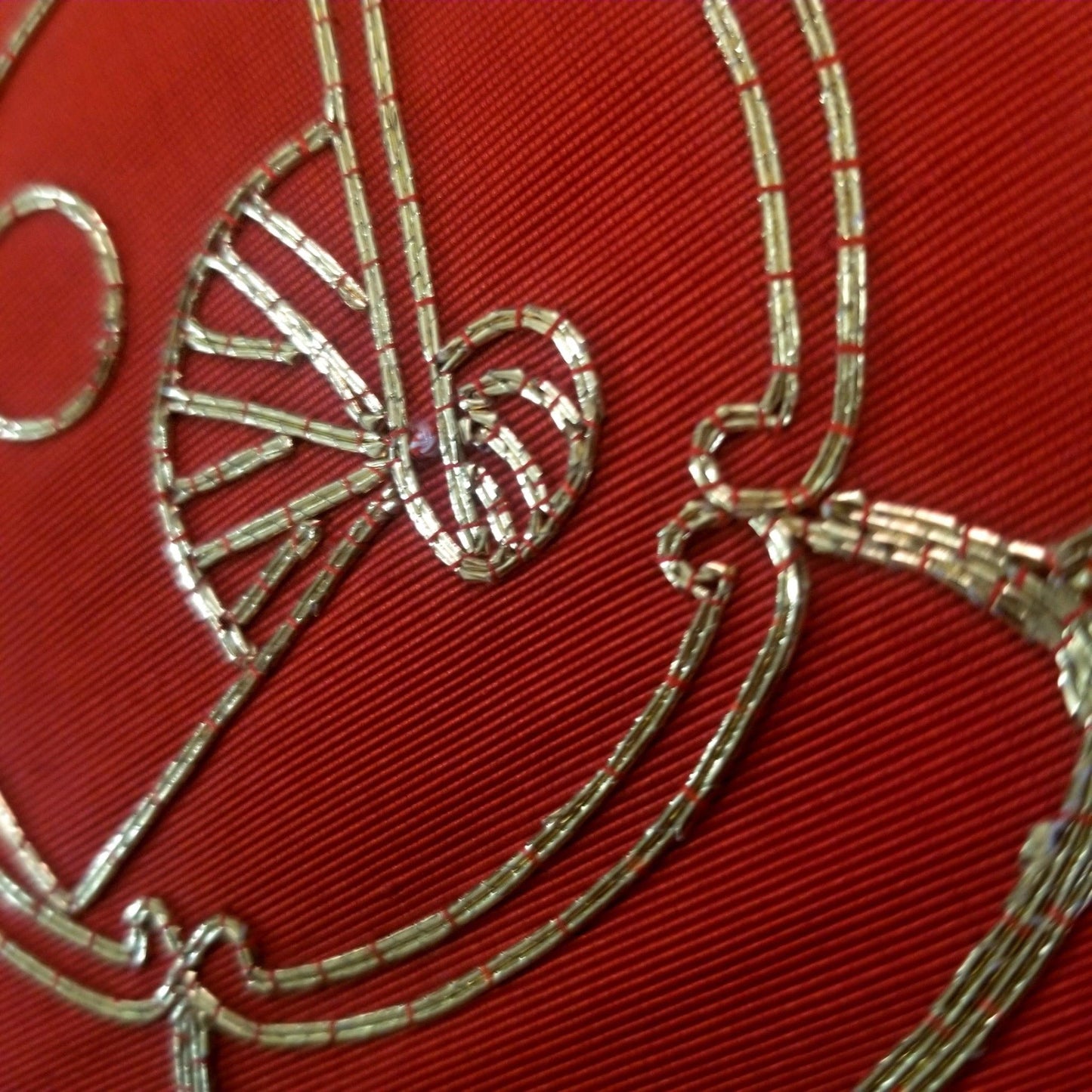
People Also Like
-
"Nagoya Co-op" Vintage Maekake Apron
Vendor:Great LogoRegular price $50.00Regular priceUnit price / per$50.00Sale price $50.00 -
"Animal Husbandry" Vintage Maekake Apron
Vendor:Feed StoreRegular price $50.00Regular priceUnit price / per$50.00Sale price $50.00 -
"Chinese Cuisine" Vintage Maekake Apron
Vendor:South of TokyoRegular price $50.00Regular priceUnit price / per$50.00Sale price $50.00 -
"Nakajima" Vintage Maekake Apron
Vendor:Great LogoRegular price $50.00Regular priceUnit price / per$50.00Sale price $50.00 -
"Wood Shop" Vintage Maekake Apron
Vendor:Rare ColorRegular price $50.00Regular priceUnit price / per$50.00Sale price $50.00 -
"Nagoya Shop" Vintage Maekake Apron
Vendor:Love the FringeRegular price $50.00Regular priceUnit price / per$50.00Sale price $50.00 -
"Hikeshi Banten" Vintage Japanese Jacket
Vendor:Fireman's JacketRegular price $80.00Regular priceUnit price / per$80.00Sale price $80.00 -
"Persimmons" Vintage Folding Fan
Vendor:Original BoxRegular price $24.00Regular priceUnit price / per$24.00Sale price $24.00 -
"Tombo" Vintage Folding Fan
Vendor:DragonflyRegular price $24.00Regular priceUnit price / per$24.00Sale price $24.00 -
"Commemoration" Vintage Folding Fan
Vendor:Antique VibeRegular price $15.00Regular priceUnit price / per$15.00Sale price $15.00 -
"Mystery Poem" Vintage Folding Fan
Vendor:Artistic BrushworkRegular price $24.00Regular priceUnit price / per$24.00Sale price $24.00 -
"Rabbit" Vintage Dance Fan
Vendor:Year of the BunnyRegular price $35.00Regular priceUnit price / per$35.00Sale price $35.00 -
"Kotobuki Shibori" Vintage Fukusa
Vendor:Jacquard SilkRegular price $19.00Regular priceUnit price / per$25.00Sale price $19.00Sale -
"Three Friends - Peach" Vintage Fukusa
Vendor:Woven ShiboriRegular price $19.00Regular priceUnit price / per$25.00Sale price $19.00Sale -
"Kai Awase" Vintage Fukusa
Vendor:Clamshell GameRegular price $39.00Regular priceUnit price / per$49.00Sale price $39.00Sale -
"Best Wishes" Vintage Fukusa
Vendor:Bon VoyageRegular price $29.00Regular priceUnit price / per$35.00Sale price $29.00Sale -
"Jo and Uba Brocade" Antique Fukusa
Vendor:Brocade WeaveRegular price $129.00Regular priceUnit price / per$149.00Sale price $129.00Sale -
"Jo and Uba Painted" Antique Fukusa
Vendor:Painted SceneRegular price $175.00Regular priceUnit price / per$199.00Sale price $175.00Sale -
"Ebisu" Furoshiki Wrapping Cloth
Vendor:Unusual Color ComboRegular price $25.00Regular priceUnit price / per$30.00Sale price $25.00Sale -
"Hikeshi Banten" Vintage Japanese Jacket
Vendor:Fireman's JacketRegular price $80.00Regular priceUnit price / per$80.00Sale price $80.00 -
"Persimmons" Vintage Folding Fan
Vendor:Original BoxRegular price $24.00Regular priceUnit price / per$24.00Sale price $24.00 -
"Tombo" Vintage Folding Fan
Vendor:DragonflyRegular price $24.00Regular priceUnit price / per$24.00Sale price $24.00 -
"Commemoration" Vintage Folding Fan
Vendor:Antique VibeRegular price $15.00Regular priceUnit price / per$15.00Sale price $15.00 -
"Mystery Poem" Vintage Folding Fan
Vendor:Artistic BrushworkRegular price $24.00Regular priceUnit price / per$24.00Sale price $24.00

